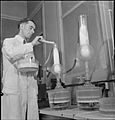Penicillin facts for kids

Penicillin is a very common antibiotic. It is a special medicine used to fight bacterial infections. It was one of the first antibiotics ever found. Penicillin worked really well against certain types of germs like staphylococci and streptococci.
However, some germs have now learned to fight penicillin. This means they are resistant to it. So, scientists keep changing parts of penicillin's structure to help it keep working against these germs.
A Scottish scientist named Sir Alexander Fleming discovered penicillin in 1928. But it wasn't made in large amounts until the 1940s. Penicillin naturally comes from a type of mold called Penicillium. Now, there are many different kinds of penicillin medicines, like penicillin G and penicillin V.
Doctors sometimes use penicillin to treat illnesses like tonsillitis, meningitis, and pneumonia. It was first used a lot during World War II.
Fleming discovered penicillin by accident. He noticed a mold that was stopping germs from growing in a petri dish. Later, an Australian scientist named Howard Walter Florey helped turn the penicillin mold into a real medicine. He worked with another scientist, Ernest Boris Chain. In 1945, Fleming, Florey, and Chain won the Nobel Prize for Medicine because of their amazing work with penicillin.
Some people are allergic to penicillin. This means their body reacts badly to it. Symptoms can include feeling sick (nausea), having diarrhea, or getting a rash. Very rarely, people with a penicillin allergy might get a fever, vomit, or have bad skin irritation. Because it's used so much, penicillin is the most common cause of serious allergic reactions to a medicine. Today, penicillin is used regularly in hospitals around the world.
Contents
How Penicillin Was Discovered

People had noticed that Penicillium mold could stop germs from growing since the late 1800s. But no one really understood why.
Then, in 1928, a Scottish doctor named Alexander Fleming was working at St. Mary's Hospital in London. He was the first to clearly show that a specific mold, Penicillium rubens, could kill germs. He proved this with an experiment on September 28, 1928. He wrote about his discovery in 1929 and called the germ-killing substance "penicillin."
Fleming thought penicillin could be a useful way to clean wounds. However, he couldn't convince other scientists that his discovery was important. This was mainly because it was very hard to get pure penicillin from the mold. It seemed impossible to turn it into a medicine. Some people think that if Fleming had been better at getting others interested, penicillin might have been developed years earlier.
Fleming's important work is now recognized. There's even a special sign at the Alexander Fleming Laboratory Museum in London, put there on November 19, 1999.
Developing Penicillin as a Medicine

In 1930, a doctor named Cecil George Paine successfully used penicillin to treat an eye infection in babies. This happened at the Royal Infirmary in Sheffield.
In 1940, an Australian scientist named Howard Florey led a team of researchers at the University of Oxford. They included Ernst Chain, Edward Abraham, and Norman Heatley. This team made great progress in making stronger penicillin from the mold.
In 1941, they treated a policeman named Albert Alexander who had a very bad face infection. He started to get better, but then they ran out of penicillin, and he sadly died. After this, they successfully treated several other patients. In December 1942, people who were burned in the Cocoanut Grove fire in Boston were the first burn patients to be successfully treated with penicillin.
The first time pure penicillin was used successfully was in 1942. Fleming used it to treat Harry Lambert, who had a deadly infection of his nervous system. At that time, the Oxford team could only make a tiny amount of penicillin. Florey kindly gave the only sample they had to Fleming. Lambert started to improve the very next day and was completely cured within a week. Fleming wrote about this success in a medical journal in 1943. Because of this medical breakthrough, the British government started a committee in 1943 to help make penicillin in large amounts.
Making Penicillin for Everyone
The Oxford team realized they couldn't make enough penicillin in their lab for everyone who needed it. They tried to get the British government to help, but it didn't work. So, in June 1941, Florey and Heatley went to the United States. They took their mold samples with them. They wanted the US government to help make penicillin on a large scale.
They went to a special lab in Peoria, Illinois, where they could make large amounts of the mold. Soon, they started growing the mold in huge tanks and looking for even better types of mold.
On March 14, 1942, the first patient in the US, Anne Miller, was treated with penicillin made by a company called Merck & Co.. Half of all the penicillin made at that time was used for her! By June 1942, there was only enough US penicillin to treat ten patients.
In July 1943, the US government made a plan to send penicillin to Allied soldiers fighting in Europe. Scientists found a moldy cantaloupe in a market in Peoria, Illinois, that had the best type of mold for making penicillin. A scientist named Jasper H. Kane suggested using a deep-tank method to make huge amounts of penicillin. A chemical engineer named Margaret Hutchinson Rousseau helped build the first large-scale deep-tank factory. Because of the war, by June 1945, over 646 billion units of penicillin were being made each year.
Another person, G. Raymond Rettew, also helped a lot. He used his knowledge of mushrooms to create ways to make large amounts of penicillin. By 1943, Rettew's lab was making most of the world's penicillin.
During World War II, penicillin made a huge difference. It greatly reduced the number of deaths and serious injuries from infected wounds among the Allied soldiers. It's thought to have saved about 12% to 15% of lives.
After World War II, Australia was the first country to make penicillin available for regular people to use. In the U.S., penicillin became available to everyone on March 15, 1945.
Fleming, Florey, and Chain shared the 1945 Nobel Prize for their amazing work in developing penicillin.
Images for kids
-
Dorothy Hodgkin figured out what penicillin's chemical structure looked like.
-
Alexander Fleming, who discovered penicillin in 1928.
See also
 In Spanish: Penicilina para niños
In Spanish: Penicilina para niños










